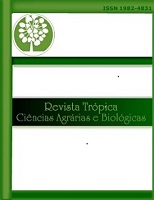STRATEGIES OF A DRY FOREST HERBACEOUS PLANT FROM SHADE TO SUN: IS IT BETTER TO INVEST IN CARBON FIXATION OR RESERVE WATER?
Keywords:
leaf area, luminosity, echological relationsAbstract
The availability of water and light affects the strategies of herbaceous plants in dry forests, acting as limiting factors for their survival. Based on these assumptions, we evaluated the responses in foliar attributes of two populations of Talinum triangulare (Jacq.) Willd., situated beneath the canopy of a shade tree (Clitoria fairchildiana R. A. Howard) and in an open field. In order to observe the adaptive responses to the environment, the question arose: is it better to invest in carbon fixation or water storage? We measured the vegetative traits of the herbaceous plants located beneath the shade tree with a projected shade radius of 8.30m, and another population located 10m away exposed to full sunlight. We found that in shaded environments, plants invest in greater leaf area and biomass accumulation but reduce the water content in their leaves. Conversely, plants in full sunlight reduce leaf area and biomass but increase their water reserves. We conclude that the evolutionary adjustments of herbaceous plants, as continuous and dynamic processes, along with the influence of "facilitating plants," are crucial for understanding the changes that occur in populations over time and for the development of potential survival strategies in the face of future climate change.
Downloads
References
ADIR, N.; SHOCHAT, S.; OHAD, I. Photoinhibition: a historical perspective. Photosynthesis Research, v. 76, p. 343-376, 2003.
ALEXANDRE, E. C. F. et al. Plant biometric characterization and leaf micromorphometry of Talinum triangulare (Jacq.) Willd cultivated under shade. Revista Ceres, v. 65, p. 44-55, 2018.
ANDRADE, J. R. et al. Influence of microhabitats on the performance of herbaceous species in areas of mature and secondary forest in the semiarid region of Brazil. Revista de Biologia Tropical, v. 63, n. 2, p. 357-368, 2015.
BADANO, E. et al. Facilitation by nurse plants contribuites to vegetal recovery in human-disturbed desert ecosystems. Journey of Plant Ecology. v. 9, n. 5, p. 485-497, 2016.
DAI, Y. et al. Effects of shade treatments on the photosynthetic capacity, chlorophyll fluorescence, and chlorophyll content of Tetrastigma hemsleyanum Diels et Gilg. Environmental and Experimental Botany, v. 65, p. 177-182, 2009.
HERRERA, A.; BALLESTRINI, C.; MONTES, E. What is the potential for dark CO2 fixation in the facultative crassulacean acid metabolism species Talinum triangulare?. Journal of Plant Physiology, v. 174, p. 55-61, 2015.
HOLMGREN, M. et al. Non-linear effects of drought under shade: reconciling physiological and ecological models in plant communities. Oecologia, v. 169, p. 293-305, 2012.
JIN, R. et al. Physiological changes of purslane (Portulaca oleracea L.) after progressive drought stress and rehydration. Scientia Horticulturae, v. 194, p. 215-221, 2015.
SILVA, L. L. R. EFEITOS DE VARIAÇÕES NA LUMINOSIDADE NO CRESCIMENTO VEGETATIVO DE Chamaecrista Rotundifolia (Pers.) Greene, UMA HERBÁCEA PERENE DA CAATINGA. 2021. 30p. Trabalho de Conclusão de Curso (Graduação). UFRPE, Recife, 2021.
SOUZA, J. D. et al. Dynamics in the emergence of dormant and non-dormant herbaceous species from the soil seed bank from a Brazilian dry forest. Journal of Plant Ecology, v. 13, n. 3, 2020.
Downloads
Published
How to Cite
Issue
Section
License

This work is licensed under a Creative Commons Attribution-NonCommercial-NoDerivatives 4.0 International License.
Direitos autorais Revista Trópica: Ciências Agrárias e Biológicas
Este obra está licenciado com uma Licença Creative Commons Atribuição-NãoComercial-SemDerivações 4.0 Internacional.








